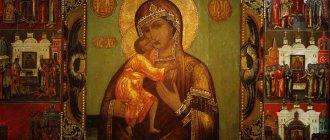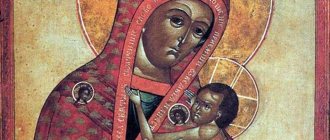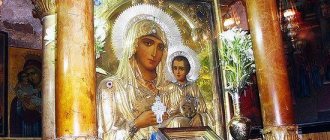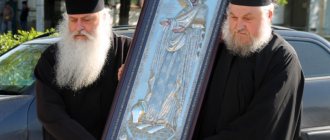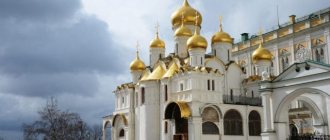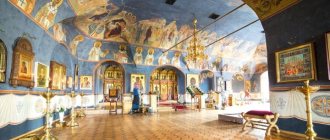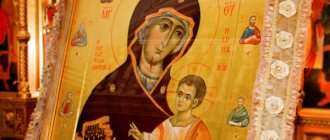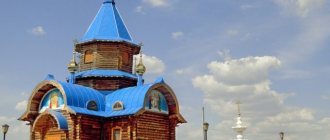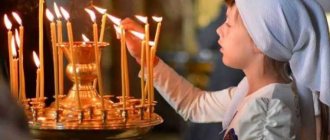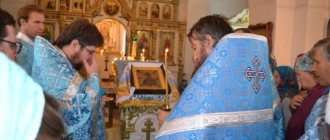Description and meaning of the image in Orthodoxy
There were two images of the Mother of God of Starorusskaya: the original, transferred to Tikhvin, and a copy of it, made in 1788. The images are radically different in the image of the Savior.
Original and copy
The icon was originally painted in the style of the Tikhvin and Georgian Hodegetria, or Guidebook. Baby Jesus turned to the Virgin Mary. The Most Pure Virgin holds it with her left hand. The Savior's right foot is depicted sideways. This image was lost during the Great Patriotic War.
The list was made by Tikhvin masters who saw the original. For some reason they distorted the image, combining elements of the Tikhvin icon and the image of the Savior, the Unsleeping Eye. The Eternal Child is depicted with his back to the Mother of God. He props up his head with his left hand, and places his right hand with a scroll on his knee. The Savior sits in the arms of the Virgin Mary, as if on a throne. The original and Tikhvin's list were revered as miraculous. The image also symbolizes the eighth commandment, “Thou shalt not steal.”
General symbolism and reasons for differences
The icons are dominated by red, regal tones. The Virgin Mary is dressed in a dark red maforium. The blue scarf on her head is a symbol of holiness. Christ is dressed in a white tunic decorated with the symbols of the Holy Trinity. A scarlet or gold cloak covers it on top.
The red cloak, or himation, symbolizes the Blood, the future sacrifice of Christ. The golden robes foreshadow His resurrection and immortality. The scroll symbolizes the wisdom of the Eternal Child and His knowledge of the Trinity Light.
The discrepancy between the list and the original is explained by two versions:
- in the Tikhvin Church the icon was treated carelessly. It was almost covered with soot, and it became difficult to make out the direction of the faces and details;
- the image was copied correctly, and Christ turned around later in the temple - due to the sinfulness of the old Rushenians.
The different position of the Savior is also interpreted as a joyful sign - He did not turn away from the Mother of God, but turned his gaze to the believers. Tikhvin residents decorated the original with jewelry: pearls, white topaz, garnet, turquoise. The head of the Mother of God and the Savior was decorated with crowns made of silver and gilding.
Explanations of the reasons for the discrepancies in the iconography of the Old Russian Icon
There are two versions explaining the difference in the iconography of the original and the list of the Old Russian Icon of the Mother of God:
- In favor of the Rushans. It is assumed that the Tikhvin people treated the holy image so carelessly that the icon painters who removed the copy could not clearly see the faces.
- In favor of the Tikhvinites. There was a version among believers that Christ on the list turned away his face at the sight of the sinful life of the Rushans. It is because of this that the 18th-century list is sometimes called the “Old Russian Sinners” icon.
Despite the different iconography, over time the list began to be revered as miraculous in the same way as the original. Now the icon of the Mother of God “Old Russian Sinners” is even more famous than the “Old Russian Tenderness”.
The icon of the Mother of God “Old Russian Sinners” now has editions - variants of iconography that have some differences from the original, but do not go beyond the canon. For example, in the Church of the Assumption of the Blessed Virgin Mary in the village of Korostyn, Novgorod region, along the lower and side margins there are miniatures with images of saints.
History of appearance
The author of the first icon is unknown, as is the exact place of its appearance. According to one version, the image appeared in the city of Vydropusk in the 16th century, and then it was transferred to Staraya Russa. But the history that began in the 10th century is considered more complete.
Finding a relic
The icon arrived in the city of Staraya Russa from the Greek Olviopolis, which was captured by the Lithuanians in the 15th century. From the occupiers the Greeks heard about the glorious Russian lands and their inhabitants who converted to Orthodoxy.
Soon in Olviopol they learned that a pestilence had occurred in Staraya Russa near Nizhny Novgorod, and priests and monastic novices had died. The Greeks were also afraid of attacks by the Tatars, who would not spare Orthodox relics. And it was decided to hand over to help the brothers in faith the icon of the Mother of God, which became famous as the Old Russian icon.
Favor
For 100 years, Staraya Russa avoided disease and war. But residents of the city of Tikhvin turned to the abbot of the Transfiguration Monastery, where the icon was kept. They suffered from the plague and asked permission to hold a religious procession with the Old Russian Icon. The abbot did not refuse the request.
The chronicles mention that one of the residents of Tikhvin had a revelation that the Old Russian Icon would save the city from pestilence. The Mother of God appeared to him in a dream and said that the disease would recede when the Tikhvin icon went to Staraya Russa, and the Starorusskaya icon to Tikhvin. The Tikhvin residents took the icon and walked around the city with it. The disease subsided, but the image did not return home.
Having lost their shrine, the residents of Staraya Russa were subjected to epidemics, natural disasters and military conflicts. Tikhvin did not consider it necessary to return the icon to the original owners, refusing even direct requests. The icon was richly decorated with precious stones, gold and silver and they did not want to part with the miraculous shrine.
Archimandrite Hilarion, rector of the Tikhvin Monastery, wrote in his notes that the clergy had not heard about the shrine belonging to the Starorushans. He found no confirmation in the chronicles, and the petitioners did not provide evidence. Therefore, their applications were rejected. To make up for the loss, the Old Rushes ordered the list, but did not give up hope of returning the original.
The end of many years of litigation
In the 18th century, cholera and uprisings raged in Staraya Russa. Representatives of the church addressed Archimandrite Tikhvinsky, the Holy Synod and the Emperor. The first refused, citing the disagreement of the flock. The head of the Synod called on Tikhvin residents to humility. And the appeal to the Sovereign came at an unkind hour of perestroika during the period of the abolition of serfdom and the attempt on his life.
Only in 1888, during another outbreak of cholera, did the residents of Old Rus achieve the return of the icon. Prince Vladimir Alexandrovich helped resolve the litigation. A richly decorated copy was brought to Tikhvin to replace the original. The decision in favor of the Starorushans met with grumbling among the Tikhvin residents. There was a rumor in the city that their archimandrite received a bribe for handing over the image.
Miraculous healing
The legends of those days say that during the transfer of this Shrine from Tikhvin to its rightful place (in Staraya Russa), many miracles occurred.
One monk was present - a resident of the Old Russian Transfiguration Monastery - Sergius. He described one of the miraculous healings that took place.
On the way, a group of women (15 people) followed the Icon of the Mother of God. They shouted in voices other than their own. They said that the women were possessed by a demon.
And those carrying the Icon could not stand it, sympathized with the unfortunate ones and lowered the stretcher. And the women were allowed to approach the Face - each 12 times.
A real miracle happened: looking at the Shrine, those healed with hot tears began to kiss the Icon and ask the Queen of Heaven for the salvation of their souls. And their prayer was heard.
What do they ask for before the image?
In ancient times, the main purpose of the icon of the Mother of God of Old Russia was to protect the city from plague and enemies.
In ancient times
According to legend, six months after the first appearance of the icon in Staraya Russa, Novgorod was threatened with capture by the Moscow principality. Novgorodians prayed in front of the Old Russian Icon so that the Most Holy Theotokos would help them defend their independence. They had numerical superiority on their side. But five thousand Muscovites beat forty thousand Novgorodians.
Later it turned out that this was God’s providence. If Novgorod had remained sovereign, it would have been captured by the Poles. Having lost one internecine battle, the Novgorodians won the foreign policy confrontation.
In addition to Tikhvin, religious processions with the Old Russian Icon of the Mother of God were held in other cities of the Novgorod principality. After the ceremony, the epidemic subsided.
In modern times
The image helps in general spiritual and life problems:
- finding family happiness;
- protecting your home from thieves and ill-wishers;
- overcoming temptations, mental weakness;
- protection of loved ones and children.
The icon spent three centuries with illegal owners. But justice still triumphed. Therefore, before the image they pray for the return of stolen property, protection from kidnappings and theft.
The icon is famous for its miracles of healing various ailments. Thanks to the prayers of the Mother of God of Starorusskaya, the grandson of the writer F. Dostoevsky was healed of cancer at the age of 25, and later of a stomach ulcer. They pray to the Old Russian Icon of the Mother of God to overcome fear, resentment, and for help in finding a way out of a difficult situation.
How does the Old Russian Icon of the Mother of God help?
It is believed that through the image of the Old Russian Mother of God, the Mother of God brings help to those suffering from serious and even incurable diseases. They also turn to this icon with prayers for the following:
- about strengthening the spirit in difficult life situations;
- about protection from enemies;
- about getting rid of the vices that corrode the soul;
- about restoring justice;
- about reconciliation with loved ones;
- about saving the souls of deceased friends and relatives.
According to believers, fervent prayer in front of this icon gives strength to overcome many difficulties and problems:
“If I feel bad, scared, someone offended me, and I get angry, if I don’t know what to do right, I always go to the Mother of God of Starorusskaya. I am sure that it is given to us according to our faith, because not a single prayer of mine to the Mother of God has gone unanswered. She always helps, strengthens and suggests a way out.”
Natalya, Novgorod region
Where can I find the original and lists
A copy of the original, transferred from Olviopol to Staraya Russa, is located in the Pokrovsko-Porechsky convent in the village of Kozya Gora, in the Leningrad region. The list of 1788 was kept in the Staraya Russa Museum during the Great Patriotic War, and then it was returned to Staraya Russa, to the Church of St. George. He is revered as miraculous today.
Fyodor Mikhailovich Dostoevsky and his family came to pray before the image at St. George’s Church. Nearby is the writer's house-museum. Now the church is open to pilgrims and tourists. The temple was built in the 15th century, but amazes nonresident guests with its cleanliness and festive atmosphere.
In the Assumption Cathedral of the Tikhvin Monastery there is a list received in 1888 to replace the original. In the 19th century, a list was made for the Church of Philip the Apostle in Nizhny Novgorod. It is kept in the Nikolsky chapel. Also, two lists are in the Old Russian churches - Trinity and Resurrection. New lists were transferred to the churches of Borisov and Korostyn.
Days of celebration
In those years when the Shrine was in Tikhvin, and then returned: first in the form of a copy (May 17, new style), and decades later the original (October 1), the tradition arose among the parishioners of Staraya Russa to celebrate the feast of the Old Russian Icon of the Mother of God on these days .
In fact, you can celebrate and honor the Shrines at any time of the year, but the clergy recommend that parishioners visit the temple on these days to pray and ask for help, support, and healing from the Queen of Heaven.
And the answer will definitely come and a real miracle can happen.
Prayer
Offering to my queen, my hope to the Mother of God, friend of the orphans and the strange, the intercessor of the sorrowful, the joyful, the offended patroness! See my misfortune, see my sorrow, help me as I am weak, feed me as I am strange. Weigh my offense, resolve it as if by will: for I have no other help except You, no other intercessor, no good comforter, except You, O Mother of God, for you will preserve me and cover me forever and ever. Amen.
Troparion
Let us now diligently approach the Mother of God, sinners and humility, and let us fall down in repentance calling from the depths of our souls: Lady, help us, having had mercy on us, struggling, we are perishing from many sins, do not turn away your slaves, for you are the only hope of the imams.
Kontakion
To the chosen Voivode, victorious, as having been delivered from the evil ones, let us write thanks to Thy servants, the Mother of God, but as having an invincible power, free us from all troubles, let us call Thee: Rejoice, Unmarried Bride.
